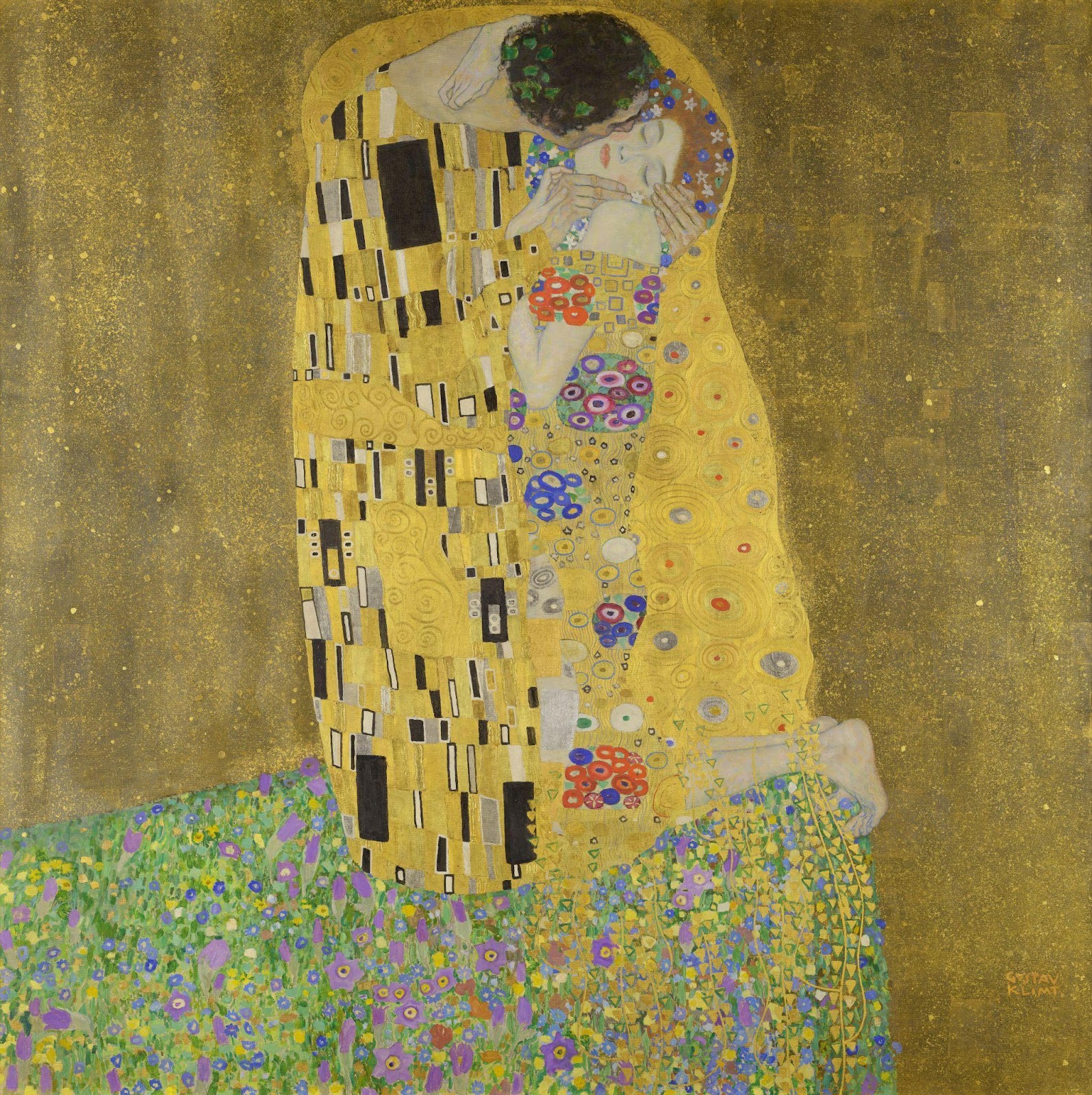Sección 8: Las emociones, las condiciones físicas y la ubicación
Sección 8: Las emociones, las condiciones físicas, y la ubicación
|
Section Goal: In this section, students will learn: to express how someone is feeling physically and emotionally. to express location |
¡A escuchar!
Actividad 28. ¿Qué significa?
Instructions: Listen to the following dialogues and try to guess the meaning of the selected words.
1. -Oye, ¿estás bien? -No, estoy enfermo.
 Enfermo means: ________________
Enfermo means: ________________
tomada de: sick man | Openverse (wordpress.org)
2. -Hola, ¿cómo estás? -Estoy muy ocupada hoy.
 Ocupada means: ________________
Ocupada means: ________________
tomada de:ton of homework | Openverse (wordpress.org) listening tomado de: Adjetivos de emoción y condición | Spanish 1 (lumenlearning.com)
Actividad 29. Las emociones
Step 1: Match the following sentences with the images.

a  b
b  c
c

e
1.__ Federico está nervioso y Maribel está sorprendida.
2.__ Ellos están enamorados. Están en la playa.
3..__ Ella está emocionada. Hoy es su graduación
4..____ Ella está preocupada. *Su (her) esposo está en el hospital.
5. ___ Mi perrito está avergonzado.
Step 2: Read the sentences again and answer the following questions.
What do you think “Ella está preocupada” means? ___________________________________________.
What do you think está means? ___________________________________________.
¿Cómo estás tú hoy? ___________________________________________.
Step 3: Complete the following chart with the conjugation of the verb estar by rereading the sentences on the previous steps
The verb estar
|
Subject pronoun (singular) |
Verb conjugation |
Subject pronoun (plural) |
Verb conjugation |
|
Yo |
estoy |
Nosotros/ Nosotras |
estamos |
|
Tú |
estás |
Vosotros/ Vosotras |
estáis |
|
Él/Ella/Elle |
está |
Ellos/Ellas/Elles |
están |
|
Usted |
está |
Ustedes |
están |
Elle: In Spanish, the pronoun elle is used to refer to an individual who identifies as gender non-binary. Elles is used to denote a group of individuals who identifiy as gender non-binary. Notice that nosotros, since it refers to a group of people (we), has three different forms.Nosotros, Nosotras, Nosotres
Vocabulario
Adjectives commonly used to describe emotions and physical conditions and used with estar.
Feliz ______________________________
Content@___________________________
Cansad@ ___________________________
Enferm@ ___________________________
Ocupad@ ___________________________
Loc@ ______________________________
Sorprendid@ ________________________
Triste ______________________________
Aburrid@ ___________________________
Nervios@ ___________________________
Preocupad@ _________________________
Emocionad@ _________________________
Enojad@/ enfadad@ ___________________
Tranquil@____________________________
Enamorad@ __________________________
Avergonzad@ _________________________
De buen/mal humor _______________________________
*For gender non-binary individuals, an -e would be added (e.g., contente, cansade, enferme, ocupade; “Yo soy contente”, “Tú eres contente”, “Elle es contente”, etc. )
El auditorio
La biblioteca
La cafetería
El centro estudiantil
El estadio
El gimnasio
El laboratorio
La residencia estudiantil
Otros lugares en el campus
La Facultad de Bellas Artes
La Facultad de Ciencias Físicas y Matemáticas
La Facultad de Ciencias Sociales y Psicología
La Facultad de Filología
La Facultad de Medicina
La Facultad de Pedagogía y Educación
Gramática

The verb estar is used to discuss states of being (conditions, emotions, feelings, etc.) and location.
Greeting people/expressing emotions, conditions, and feelings:
-¿Cómo estás? -Yo estoy cansada porque trabajo mucho.
-Tú estás enamorado de Carmen, ¿no?
-Ella está triste hoy.
-Nosotras estamos nerviosas porque tenemos un examen.
-Vosotros estáis tranquilos.
The verb “estar” is also used to express location:
-¿Dónde está Renata? -Ella está en clase.
-¿Dónde está la biblioteca? –Está al lado del centro estudiantil.
-Mi profesora de biología está en el laboratorio.
-Todos mis amigos están en clase.
Prepositions commonly used with estar
*Use de when giving a reference point.
En ___________________________________________
Aquí __________________________________________
Allí _____________
Al lado (de) ___
Lejos (de)______________________________________
Cerca (de) _________
A la derecha (de)
A la izquierda (de)
Number in Adjectives
Adjectives can describe an element or a group (singular or plural): singular refers to one person/a place/an object, etc. while plural refers to more than one element.
*If you are using an adjective to describe a noun that is a plural form, the adjective has to be in its plural form as well. You previously studied plural formation in nouns. A similar pattern is used to make adjectives plural.
Plural adjectives: To make and adjective plural
-if the adjective ends with a vowel, add -s
Ejemplo: La biblioteca es grande.
Los dormitorios son grandes.
*adjective grande adds an s in grandes when describing the plural noun los dormitorios
-if the adjective ends with a consonant, add es
Ejemplo: La biblioteca es grande.
Los dormitorios son grandes.
-If the adjective, ends with an -z, change the z to c before adding -es
Ejemplo: La profesora está feliz.
Los estudiantes están felices.
*In the example above, when the adjective feliz is used to describe the professor (singular), the adjective feliz is used in its singular form. When the same adjective is needed to describe the students (plural), the adjective feliz is used in its plural form, felices. Notice how the z also changed to a c.
Gender in Adjectives
Adjectives also have a gender. If you are describing a masculine noun, the adjective takes its masculine form. On the other hand, if you are describing a feminine noun, the adjective takes it feminine form.
Ejemplo:
El libro es pequeño.
La mesa es pequeña.
* Adjectives in their masculine form, usually end with an -o and adjectives in their feminine form, usually end with an -a.
There are a few exceptions to this rule. For example, the adjectives “optimista” and “pesimista”, are neutral adjectives, although ending with an –a describe both masculine and feminine nouns. Other neutral adjectives are the ones that end with an –e or in a consonant.
Ejemplo:
Pedro es optimista pero Marta es muy pesimista.
El perro es leal.
Ella es inteligente.
¡A mirar!
Actividad 30. ¿Cómo están?
Instructions: Write the proper form of the verb estar in each blank.
Taken from: 6.7 The Verb Estar – Introducción al Español (pressbooks.pub)
1. Yo _________________ contenta.
2. Marisol _________________ triste.
3. Nosotros _________________ cansados.
4. Felipe _________________ emocionado.
5. Ellas _________________ aburridas.
6. Elena _________________ enferma.
7. Vosotros _________________ enojados.
8. Yo _________________ preocupado.
9. Juan y María _________________ estresados.
10. Tú _________________ nervioso.
11. Pablo y yo _________________ enamorados.
Actividad 31. Los emojis.
Taken from  pixabay
pixabay
Instructions: Draw 4 emojis and guess their meaning
Step 1: Select four vocabulary words related to emotions and draw an emoji for each of them.
|
|
|
|
|
|
Step 2: Switch papers with a partner and guess each of them by asking:
“¿Está _________________ ?”
To respond, answer using:
“Sí, está ,” or, “No, no está .”
Continue until you have correctly guessed each one of your partner’s emojis and until they have guessed each one of yours.
Modelo: ¿Está feliz?
Sí, está feliz
Actividad 32. ¿Cómo están?
Contexto: In the video, Mayra expresses how she feels in specific situations
Instructions: Watch the video and answer the questions in complete sentences.
Step 1: Answer the question ¿Cómo está ella cuándo…? in each case.
Modelo: ¿Cómo está Mayra hoy (today)?
Ella está muy bien.
1. ¿Cómo está Mayra cuando tiene un examen?
___________________________________________________
2. ¿Cómo está el día de su cumpleaños?
___________________________________________________
3. ¿Cómo está ella cuando tiene una cita*? *date
___________________________________________________
4. ¿Cómo está cuando trabaja y estudia mucho?
___________________________________________________
5. ¿Cómo está cuando está en la playa?
___________________________________________________
Step 2: Answer how you are in each situation.
Modelo: ¿Cómo estás?
Yo estoy feliz.
¿Cómo estás hoy?
___________________________________________________
¿Cómo estás cuando tienes un examen?
___________________________________________________
¿Cómo estás el día de tu cumpleaños?
___________________________________________________
¿Cómo estás cuando tienes una cita (date).
________________________________________________
¿Cómo estás cuando trabajas y estudias mucho?
___________________________________________________
¿Cómo estás cuando estás en la playa?
___________________________________________________
¡A mirar!
Actividad 33. Pinturas famosas.
Instructions: Look at the following works of art and answer the questions.
Modelo:
Cuadro 1
Título: El beso
Artista: Gustav Klimt, Austria, 1901-1908
Ubicación: Galería Belvedere, Viena, Austria
Questions:
1. ¿Cómo se llama el cuadro? El cuadro se llama el beso.
2. ¿Cómo están las personas? Ellos están enamorados.
3. ¿Dónde está el cuadro? El cuadro está en la galería Belvedere en Viena, Austria.
Cuadro 1

tomada de: Little Girl in a Blue Armchair (nga.gov)
Título: Niña pequeña en un sillón azul
Artista: Mary Cassat, Estados Unidos, 1878
Ubicación: Galería Nacional de Arte, Washington D.C., Los Estados Unidos
Questions:
¿Cómo se llama el cuadro? ____________________________
¿Cómo está la niña? _________________________________
¿Dónde está el cuadro? _______________________________
Cuadro 2
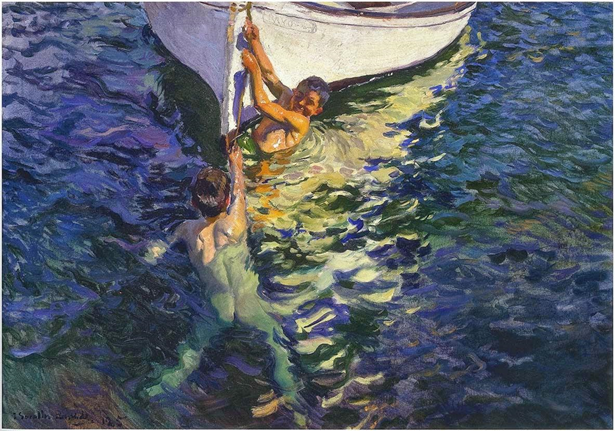
tomado de: El bote blanco – Joaquín Sorolla – Historia Arte (HA!) (historia-arte.com)
Título: El Bote Blanco
Artista: Joaquín Sorolla, España, 1905
Ubicación: Museo Sorolla, Madrid, España
Questions:
¿Cómo se llama el cuadro? ____________________________
¿Cómo está el niño? _________________________________
¿Dónde está el cuadro? ______________________________
Cuadro 3
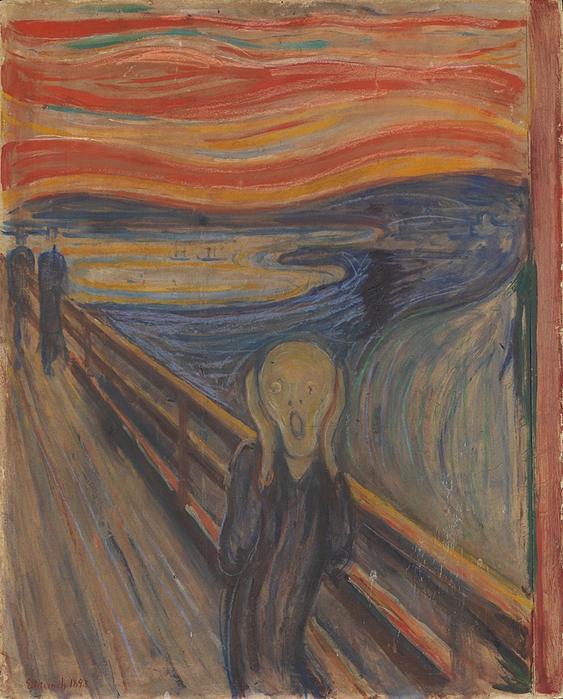
Título: El grito
Artista: Edvard Munch, Noruega, 1893
Ubicación: La Galería Nacional, Oslo, Noruega
Questions:
¿Cómo se llama el cuadro? ____________________________
¿Cómo está el hombre? ____________________________
¿Dónde está el cuadro? ____________________________
Actividad 34. ¿Dónde está?
Instructions: Work with a partner to discuss where the items are on the desk using the verb estar + prepositional phrases from our vocabulary.
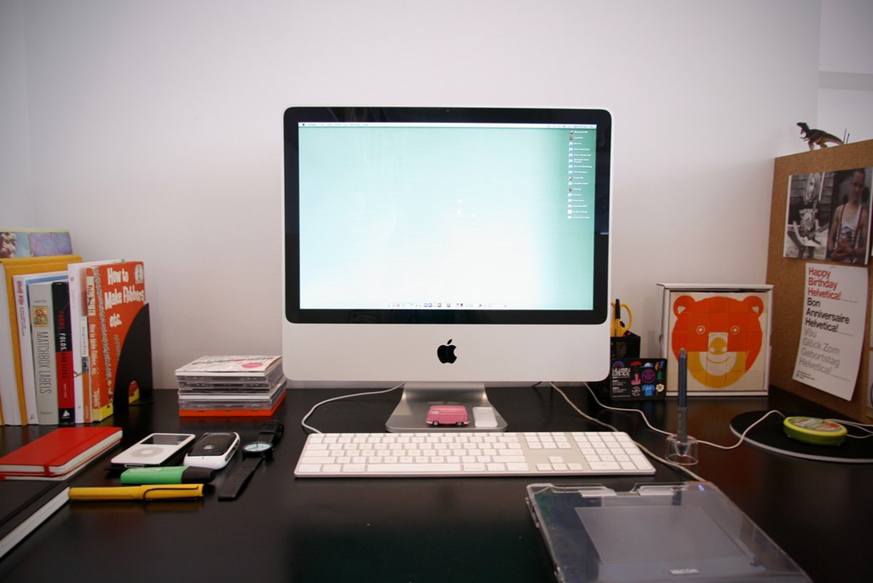
Modelo: Los libros están al lado de la computadora.
1. El bolígrafo _______________________________________ del cuaderno.
2. La computadora _______________________________________ de los discos compactos.
3. El dinosaurio _______________________________________ de los libros.
4. Las fotografías _______________________________________ del dinosaurio.
¡A leer!
Actividad 35. Dos universidades grandes
Instructions: Read the text and correct the false statements based on the reading by first negating the statement and then writing the correct one.
Modelo: La Universidad Complutense de Madrid es pequeña.
La Universidad Complutense de Madrid no es pequeña. La Universidad Complutense de Madrid es otra universidad grande.
tomado y adaptado de Cultura: La universidad | Spanish 1 (lumenlearning.com)
La Universidad Nacional Autónoma de México (UNAM) es la universidad principal de México. Está ubicada en Coyoacán, México D.F. La UNAM tiene 41 programas de posgrado (graduate-level), y 127 carreras o especializaciones de licenciatura (undergraduate-level). Incluso hay 3 programas de bachillerato (high-school level). ¡Es muy grande!
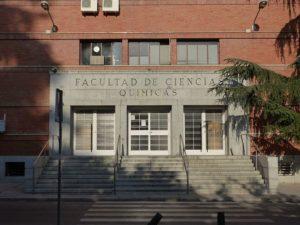
La Universidad Complutense de Madrid en España es otra universidad grande. Los profesores investigan muchas ciencias diferentes, y enseñan a estudiantes de licenciatura y posgrado en 26 facultades. En la Facultad de Filología hay 7 departamentos de lenguas y literatura, por ejemplo el Departamento de Estudios Ingleses, y el Departamento de Lengua Española y Teoría de la Literatura. Pero no necesitas estudiar en una universidad. Hay muchos institutos de español para estudiantes extranjeros en España y en toda Latinoamérica. Es posible estudiar el español para crédito académico o sin crédito y es posible tomar cursos en otoño, primavera, verano– ¡o por un año entero!
El bachillerato en México es igual al ‘bachelors degree’ en EEUU. _________________________
La Facultad de Filología en la Complutense es para estudiar ciencias._______________________
Los estudiantes extranjeros en España solamente toman clases por crédito académico.___________________________
Actividad 37. Lugares en la universidad
Instructions: Match the place depicted in the pictures with its descriptions. Use the following vocabulary list fo in case you need help https://courses.lumenlearning.com/wm-spanish1/chapter/vocabulario-la-universidad/
Modelo: El auditorio: En el auditorio, escuchamos música clásica. 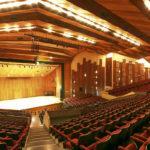
Lugares
1._________ 2._________
2._________
3._________ 4._________
4._________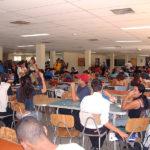
5._________  6.__________
6.__________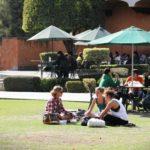

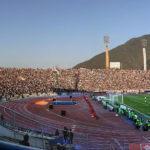
7.____________ 8. ______________
Las descripciones
La biblioteca: En la biblioteca hay muchos libros.
La cafetería: Es ideal para comer pizza y tomar café.
El centro estudiantil: Tiene un plan de actividades para los estudiantes.
El estadio: En el estadio, miramos los partidos de fútbol americano.
El gimnasio: Hacemos ejercicios.
El laboratorio: Los experimentos de química y biología ocurren aquí.
La residencia estudiantil: Yo estoy en la residencia después de las 11 de la noche.
La librería: En la librería, un libro de matemáticas cuesta $13 pesos y un lápiz cuesta $1 peso.
“Vocabulario: La universidad” by SUNY Oneonta with Lumen Learning is licensed under CC BY 4.0
¡A esbribir!
Actividad 38. En nuestro campus
Instructions: Work with a partner to discuss where on campus one can find the places below. Respond to the questions based on your campus. Make sure to include some prepositional phrases from our vocabulary in your responses (al lado de/cerca de/lejos de, etc…).
Modelo:
¿Dónde está la Facultad de Medicina?
La Facultad de Medicina está cerca de la biblioteca.
1. ¿Dónde está la biblioteca?
______________________________________________________.
2. ¿Dónde está la cafetería?
______________________________________________________.
3. ¿Dónde está el gimnasio?
______________________________________________________.
4. ¿Dónde está la residencia estudiantil?
______________________________________________________.
¡A hablar!
Actividad 39. Un encuentro
Context: Imagine that Pablo, a new student in your Spanish class, arrives at the classroom where you have been waiting outside for the professor and the rest of the students to arrive.
Instructions: Work with your partner to write a dialogue between the university professor and the student and act it out.
Step 1: Write the dialogue.
|
Pablo |
el estudiante/la estudiante |
la profesora de español |
|
1-Greet the student 2-Ask how he/she is 4-Respond to the question and introduce yourself 5-Ask his/her name 7- Respond to the introduction. Ask the name of the Spanish teacher 10. Respond to the Spanish professor |
3-Respond and ask the same question 6- Respond to the introduction and express your name 8-Respond to it 10. Respond to the Spanish professor 11. Ask how she is
|
9- (*arriving) Join the conversation by asking the students how they are. 12- Respond and invite the students to enter the classroom: Pasen, por favor. |
Step 2: Select one character and act it out with your partner. (Pablo/el estudiante/la estudiante/ la profesora de español)


